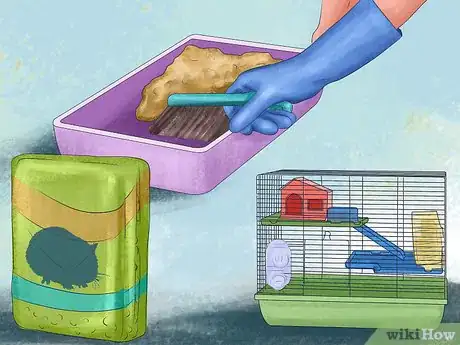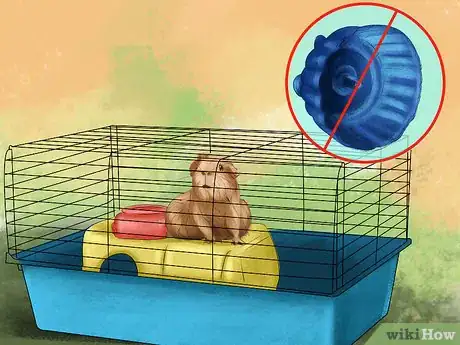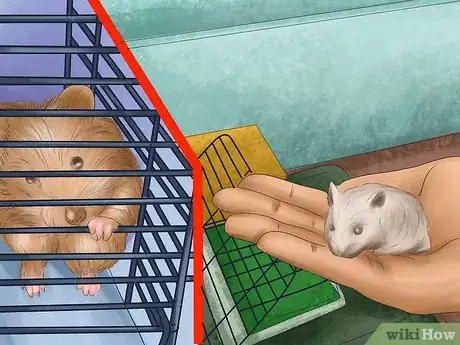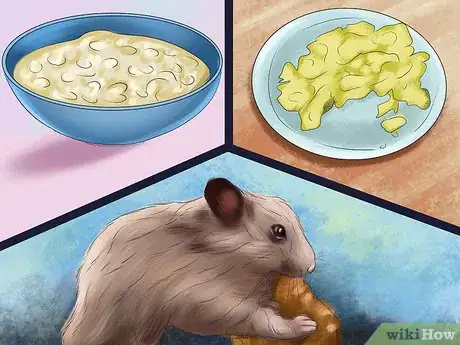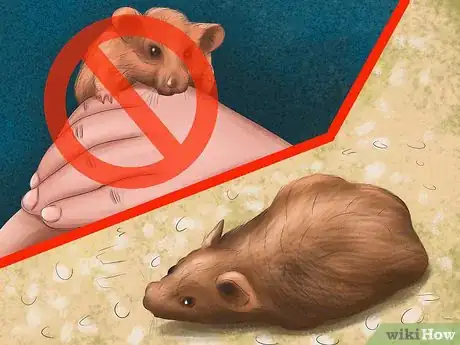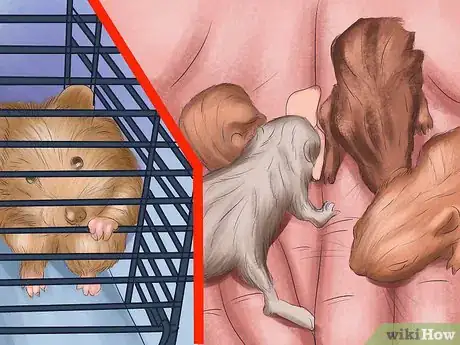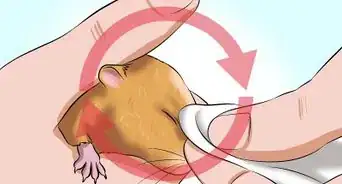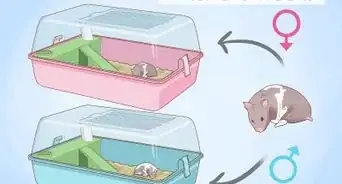This article was co-authored by Pippa Elliott, MRCVS. Dr. Elliott, BVMS, MRCVS is a veterinarian with over 30 years of experience in veterinary surgery and companion animal practice. She graduated from the University of Glasgow in 1987 with a degree in veterinary medicine and surgery. She has worked at the same animal clinic in her hometown for over 20 years.
This article has been viewed 28,027 times.
The care and maintenance of a mother hamster before, during, and after birth is very important for the survival of the mother and her babies. Make sure the cage is properly prepared before the birthing takes place. Also, because the birthing process requires a lot of energy, ensure that the mother has enough water and is continually fed a high-protein diet throughout the process.
Steps
Preparing the Birthing Area
-
1Use a cage that is a tank. When preparing for your hamster to have her babies, use a cage that is tank-like, i.e., like a fish tank with glass walls. You want to use a tank-like cage because it reduces the risk of the babies escaping through the wire bars, if the cage you have is a wire cage.[1]
- Also, you want to have a cage that is only one-story high. Cages that have multiple stories can cause the mother to make her nest on one of the second or third floors. This is risky because one of the hamster babies could fall and hurt themselves or die.
-
2Clean the cage and add extra bedding. You want to clean the cage 3 to 4 days before the mother goes into labor. Clean the cage as you normally would, but add extra bedding. Pad the cage with extra bedding material that you usually buy. You can also add shredded pieces of toilet paper for extra bedding. However, do not use commercial fluff or wool to add extra bedding. This kind of bedding can cause harm if the hamster eats it or if one of its limbs becomes caught in the fine fibers.
- Signs that mother is pregnant and will be going into labor are: a sudden increase in weight gain, nipple protrusion, an aggressive temperament, nest building, and an increase in eating and drinking.[2]
Advertisement -
3Remove the wheel and toys from cage. Also, remove the hamster wheel, any hamster toys, and tubes/tunnels that are inside the cage. You want to remove these because they can injure the hamster babies.[3]
-
4Remove other hamsters from cage. If your pregnant hamster is sharing a cage with other hamsters, move these hamsters to another cage. These hamsters might disturb the mother and her preparations, or they might harm or eat the babies once born.[4]
Preparing the Mother for Birth
-
1Give her extra water. When you notice the mother drinking a lot more water than usual, this is a sign that she will be having her babies soon. Therefore, make sure her water bottle is always full. You can also provide extra water by hanging another water bottle in her cage.
-
2Feed her a high protein diet. When the hamster mother is close to having her babies, she will also be eating more than usual. She eats more than usual because she wants to ensure that she has enough energy for the labor process. Therefore, make sure her food bowl is always stocked. It is also important to supplement her diet with extra nutrients, i.e., food that is high in protein, to help her with the pregnancy.[5] Here are some foods that you can supplement her diet with:[6]
- Scrambled egg whites
- Chicken or tofu
- Porridge
- Bread soaked in skim milk
-
3Do not hold or handle the mother. When the time for having her babies is near, the mother might become unusually aggressive. So, unless it is absolutely necessary, try not to handle or hold the mother during this time. If you do, she might bite you to let you know she is uncomfortable with being held.[7]
-
4Place the cage in a quiet room. Make sure the cage is in a quiet room, away from any loud noises in the house. Loud noises can stress and disturb the mother during and after birth, which can cause her to harm her babies.
Providing Care During and After Birth
-
1Do not disturb the mother or her babies. You will know the mother is in labor when you hear little squeaks coming from the cage. Be very careful to not intervene during this process. The mother will give birth in 10 to 30 minute intervals. Either way, it can happen quickly, or take several hours.
- If you disturb the mother, this can cause her to stress and possibly harm one of her babies.[8]
- Continue to leave the mother and babies alone until the babies have been alive for 2 weeks.
-
2Continue to supply her with food and water. The birthing process requires a lot of energy from the mother. Make sure the mother has a constant supply of water and is continually fed a high protein diet throughout the entire process.[9]
- Make sure the water bottle and food bowl are easily accessible for you so you can re-supply them without disturbing the mother. Do not resupply during or right after the labor process. Wait a couple hours before checking and resupplying.
-
3Keep the mother separated. The mother is fertile again 24 hours after birth. Therefore, for the safety of the mother and her babies, do not put other hamsters back in the cage. Generally, you want to minimize contact with the mother for up to two weeks. Hamster babies will be mature enough to leave their mother at three to four weeks of age.
- If you keep the babies longer than four weeks, make sure to remove the babies from the mother before eight weeks of age. Remove the babies into gender specific living groups, unless you want an explosion of hamster babies.[10] At eight weeks, the hamsters will be able to reproduce and could possibly reproduce with the mother.
Warnings
- If the mother never has her babies, it could be phantom pregnancy, or another complication. If so, do not worry because the unborn hamsters will be reabsorbed back into the mother’s blood stream.⧼thumbs_response⧽
- Never introduce the baby hamsters to the father hamster; he may harm them.⧼thumbs_response⧽
- Do not touch the babies once they are born. This can cause the mother to harm or neglect her babies. If you have to move a baby hamster, use a plastic spoon, rubbed in the mother’s toilet area, to pick up the baby and place it near the mother's nest.[11]⧼thumbs_response⧽
References
- ↑ https://hamsters-uk.org/content/view/76/64/#hampreg
- ↑ https://pethamstercare.com/breeding-babies/
- ↑ https://hamsters-uk.org/content/view/76/64/#hampreg
- ↑ http://animals.mom.me/hamster-having-babies-1451.html
- ↑ https://hamsters-uk.org/content/view/76/64/#hampreg
- ↑ https://hamsters-uk.org/content/view/76/64/#hampreg
- ↑ https://www.cuteness.com/article/recognize-hamster-pregnant
- ↑ http://animals.mom.me/hamster-having-babies-1451.html
- ↑ https://hamsters-uk.org/content/view/76/64/#hampreg
About This Article
To take care of a hamster that is giving birth, start by cleaning a glass fish tank and lining it with several layers of soft bedding. Remove any other hamsters from the cage and let the mother have the space to herself. Pregnant hamsters can be a little aggressive, so avoid handling her in the days leading up to birth. Also, provide extra water and plenty of high protein food during this time. Once labor begins, it's important not to disturb the mother or intervene with the process. Continue supplying food and water and keep the mother and her babies separated from other hamsters for at least 2 weeks. For more tips from our Veterinary co-author on how to treat a hamster in labor, read on!

